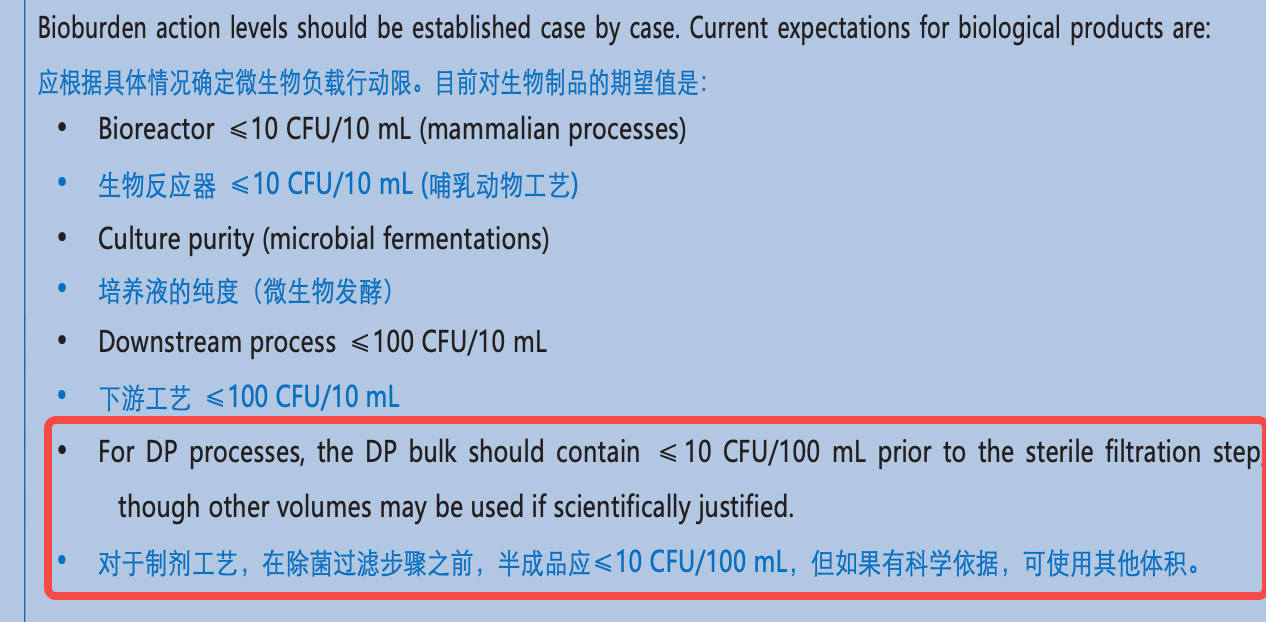建议参考PDA技术文章:Microbial Monitoring For Biological Drug Substance Manufacturing: An industry Perspective,整个生物制品的微生物控制从上游收获工序一直到最终的原液除菌过滤,微生物控制限度的标准从宽松到加严,逐级推进。以下是关于微生物限度的一些描述,可参考:
Unlike non-sterile dosage forms, there are no recom-mended bioburden levels provided in regulatory guidelines or compendia for the protein purification processes of biologic or other biopharmaceutical prod-ucts, therefore, manufacturers are responsible for set-ting bioburden control levels for biologic production processes. The BioPhorum Operations Group (BPOG) Bioburden Working Group conducted a member survey of bioburden action levels and found that the majority of biologic processes action levels were set between 1 and 10 CFU/mL. When control levels (i.e., action and/or alert levels) are set appropriately, drifts or deviations from normal operating conditions can be promptly detected, investigated, and remediated. When control levels are not set appropriately (e.g., tooloose or too tight), a loss of microbial control may go undetected or unnecessary investigations may be per-formed. Therefore, setting appropriate control levels isa key component of a successful microbial control strategy.
与非无菌剂型不同,对于生物制品或其他生物制药产品的蛋白质纯化过程,监管指南或药典中没有提供推荐的生物负荷水平,因此,制造商负责为生物生产过程设定生物负荷控制水平。BioPhorum Operations Group (BPOG)生物负荷工作组对生物负荷作用水平进行了成员调查,发现大多数生物负荷的水平设定在1至10 CFU/mL之间。当控制水平(即行动和/或警报水平)被适当设置时,可以及时发现、调查和纠正偏离正常操作条件的漂移或偏差。当控制水平设置不适当(例如,工具松动或太紧)时,可能无法发现微生物控制的丢失,或者可能进行不必要的调查。因此,设定适当的控制水平是成功的微生物控制策略的关键组成部分。
重要的事情先说,制定微生物标准不是写数学题,10cfu/100ml不能简化为1cfu/10ml;这两个标准代表的意义是截然不同的。
首先是判断标准的问题,10cfu/100ml可以解读为每100ml中不得超出10个微生物,而1cfu/10ml则意味着每10ml中不得超出1个微生物,这里特别注意已经不自觉的把bioburden变成了一个无菌问题。
然后是取样量抑或回收率的问题,微生物污染的分布是不均匀的,因此样品量越多越能体现出真实的微生物负荷水平,这是基本的共识。
最后我想说的是,微生物标准是要结合实际情况制定的,而不是把10cfu/100ml当成金标准!
这{{threadTextType}}正{{isAdminText}}
为帮助审核人员更快处理,请填写举报原因:
为帮助审核人员更快处理,请填写举报原因:


